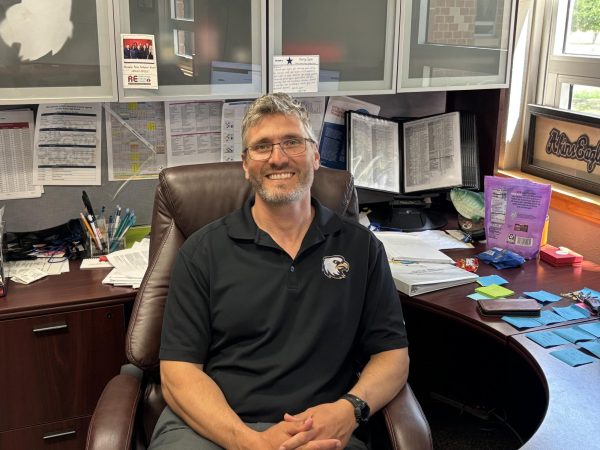Fentanyl dialogue needed to prevent death
Fentanyl, a deadly synthetic opioid that is stronger than heroin, is killing thousands of teens and young adults in America every year.
The fentanyl overdose epidemic is a serious issue killing the teens in Austin and our surrounding communities. Since the beginning of the school year, there have been at least five students in Hays CISD who have died from fentanyl overdoses.
Why are these teens even thinking of taking this drug? Where did it come from? How are they getting it? And what’s so dangerous about fentanyl?
Lately, in our generation of teens, there has been an up sore of a sick glamorization of taking painkiller pills like Percocet for recreational purposes to get high. This can be heard in songs like “The Percocet & Stripper Joint” “Perc & Sex,” Perc Popper,” “Perc 10” and so many more within lyrics of their songs from artists like Future, Yn Jay, Migos, Young Thug, Lil Double 0, and so many other famous rappers teens look up to.
These artists are rapping about taking “percs” and it’s leading to teens trying them just to feel cool like their favorite rapper but they get hooked or sadly overdose on these pills. And what has made the problem even worse today is that when young people buy these pills online or via social media, they are often actually taking counterfeit versions that are actually made with fentanyl.
Some teens have heard about Narcan, which is the brand name for a fast-acting medication called naloxone that can rapidly reverse an opioid overdose. However, it is possible for a person to still experience the effects of an overdose after a dose of naloxone wears off, according to the National Institute on Drug Abuse. Some stronger opioids might require multiple doses of naloxone.
Therefore, one of the most important steps to take is to call 911 so the individual can receive immediate medical attention.
Some teens may get lucky and have Narcan with them or someone by them has Narcan. However, Narcan only lasts over a 30-90 minute time frame and the teen can go back into an overdose if they still have fentanyl in their system and don’t get help fast enough.
Sadly, there are some people who are so addicted to opioids or in so much mental distress that they actually want to take fentanyl even knowing that it is effectively 50 to 100 times more potent than heroin or prescription opioids. This often happens when people have already taken other opioids and are looking for a stronger high or because the pills they used to take just don’t have the same effect as they used to.
At this point, drug users either face one of three outcomes:
The user overdoses but gets lucky if a friend, family member or emergency personnel can reverse the overdose.
The user dies.
The possibility of getting clean and stopping taking these kinds of drugs depends on whether users can avoid overdosing and successfully completing a rehab program. However, this is sadly the least likely outcome because many users will eventually experience a relapse and need to go back into treatment more than once.
Many elected officials in Texas are taking a “war on drugs” approach by focusing on the smuggling of fentanyl pills into the United States from countries like Mexico. Both the U.S. Drug Enforcement Administration and Gov. Greg Abbott are pushing a “one pill can kill” messaging campaign meant to scare teens away from drugs.
While the idea that a single fentanyl pill can kill is true, it’s naive to think that the problems of teens and drug users in general can be stopped by cracking down on the smuggling and trafficking of drugs that can be made and smuggled easily even within the United States.
If we are ever going to grow and slow down the overdose rates, we need to realize that users of fentanyl pills are not always overdosing as an accident. We need to do more than just scare people by pointing out the alarming potency of these deadly drugs.
I do believe that schools should be hosting mandatory student assemblies and presentations about the dangers of fentanyl; however, we also need to avoid stigmatizing the topic of drug use and why teens might be taking these drugs.
People need to understand why teenagers are using these pills and how we all can recognize warning signs and help people get the mental health treatment they need to avoid becoming a user.
The current fentanyl epidemic can be compared to the crack epidemic in the 1980s. Just like then, adults today aren’t educated enough about these fentanyl pills and don’t know what to do if they suspect their own kid might be using these drugs.
Sadly, in American society, it’s widely believed that if someone takes drugs, they are just a junkie and have no other value. This can reinforce users’ own beliefs about themselves in thinking that they can’t get help or are too far gone to get help or treatment. If we as a community break this stigma we can help save teens silently struggling with addiction.
The reality is that many teens turn to drugs and fentanyl as a means to cope by dulling the pain of their everyday lives.
Akins is fortunate to have the Student Support Services (SSS) office that works to spread awareness about substance addiction. SSS Director Meg Kozel works to make sure parents have resources and the support needed for students who are struggling with any kind of substance addiction.
Kozel said that often, seeking out drugs and alcohol comes from something small, including a lack of coping skills or “not feeling like you have anyone to talk to right about anything that you’re going through.”
Kozel said her main goal in spreading awareness is to make sure teens have anything they need and make sure they understand the real dangers that come with taking drugs.
Alana Bejarano, Austin ISD’s Director of Health Services, has helped launch a fentanyl awareness campaign for the school district that includes resources for campuses. Also, the health services team works with the School Health Advisory Council and on social media to provide resources to students and families. The main way Austin ISD has spread awareness is online and by working with other districts. Bejarano said she wants to make the subject of fentanyl use more talked about with families, and help students who don’t know when they don’t know where to turn for help.
I feel that if we are going to make a change we need to be public and make time to hear directly from those whose lives have been affected by the fentanyl epidemic. Hays CISD has prioritized fentanyl education among the student body with the help of family members who have lost their children, brothers and sisters to fentanyl overdoses. One of those is Janel Rodriguez, who started the website www.Forever15Project.org after her son Noah Rodriguez died from an overdose last year.
Janel Rodriguez has openly shared the story of how Noah overdosed while staying over a friend’s house in August. His friend’s mother performed CPR on Noah while waiting for paramedics to arrive, but it wasn’t enough to save him. Janel Rodriguez has dedicated her life since then to educating parents and students about the dangers of fentanyl. In a YouTube video posted on her website she warns parents to avoid thinking “not my child” when thinking of the dangers of drug abuse. Janel didn’t let the loss of her son break her through.
Janel is today one of loudest advocates for fentanyl and overdose education in our area. She continued to share Noah’s story so parents, teens, elected officials, educators, and the community at large can know about the dangers of drug abuse to stop more kids from dying.
To lower death rates we must all have an open and serious conversation in our school communities.We need to stop acting like it’s not happening or that it’s not a real problem. Thousands of more American teens could die in this fentanyl crisis, if we don’t deal with it properly.
Your donation will support the student journalists of Akins High School. Your contribution will allow us to purchase equipment and cover our annual website hosting costs.













